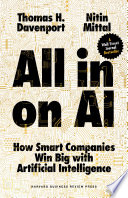

The integration of AI into the workplace is reshaping job roles and responsibilities. The book explores how AI can augment human capabilities rather than replace them, highlighting the potential for increased productivity and job satisfaction. It discusses the importance of reskilling and upskilling the workforce to adapt to new technologies, emphasizing that employees must embrace change and be proactive in their career development. The author provides insights into the types of skills that will be in demand in an AI-driven economy, advocating for a focus on creativity, emotional intelligence, and complex problem-solving as essential competencies for the future.
Continue readingArtificial Intelligence (AI) is no longer a futuristic concept; it has become a transformative force across industries. The book delves into how AI reshapes traditional business models, enhances operational efficiencies, and creates new avenues for innovation. It emphasizes that organizations must embrace AI not merely as a tool but as a fundamental component of their strategic vision. The author illustrates this idea with numerous case studies showcasing companies that have successfully integrated AI into their core functions, resulting in significant competitive advantages. The narrative stresses the importance of understanding AI's capabilities and limitations, encouraging leaders to foster a culture of experimentation and adaptability within their organizations.
Continue readingWith great power comes great responsibility, and this principle is particularly relevant in the context of AI. The book discusses the ethical implications of AI technologies, including concerns around bias, privacy, and accountability. It highlights the necessity for organizations to implement ethical guidelines and frameworks that govern AI use. The author argues that companies must prioritize transparency and fairness to build trust with consumers and stakeholders. This section of the book also explores the role of policymakers and industry leaders in establishing regulations that ensure responsible AI deployment, advocating for a collaborative approach to address potential societal impacts.
Continue readingThe concept of data being the new oil is a recurring theme in discussions about AI. The book emphasizes the critical role of data in powering AI systems, likening it to the fuel that drives innovation and growth. It outlines strategies for organizations to effectively collect, manage, and analyze data to unlock the full potential of AI. The author addresses the challenges of data quality and accessibility, urging businesses to invest in robust data infrastructure. Furthermore, the book discusses the importance of data governance and security, underscoring that organizations must safeguard their data assets to maintain competitive advantage and comply with legal standards.
Continue readingFor organizations to successfully leverage AI, they must cultivate an AI-ready culture. The book outlines the key elements of such a culture, including fostering a mindset of continuous learning, encouraging cross-functional collaboration, and promoting diversity in teams. The author stresses the importance of leadership in driving cultural change, advocating for leaders to model the behaviors they wish to see. Additionally, the book provides practical tips for organizations to upskill their workforce, ensuring employees are equipped with the necessary knowledge and tools to thrive in an AI-driven environment. This cultural shift is portrayed as essential for sustaining innovation and agility.
Continue readingImplementing AI strategically is crucial for maximizing its benefits. The book outlines a roadmap for organizations looking to adopt AI technologies, including defining clear objectives, selecting appropriate use cases, and measuring success. The author stresses the importance of aligning AI initiatives with overall business strategy, ensuring that AI projects contribute to organizational goals. Furthermore, the book addresses the potential pitfalls of AI implementation, such as overhyping capabilities or underestimating the resources required. By providing a structured approach to AI adoption, the author empowers organizations to navigate the complexities of the AI landscape effectively.
Continue readingThe book concludes with an overview of the global AI landscape, examining how different regions are approaching AI development and adoption. It highlights the competitive dynamics between countries, particularly the race between the U.S. and China in AI innovation. The author discusses the implications of these geopolitical factors for businesses operating in a global marketplace. Additionally, the book explores the role of international collaborations and partnerships in advancing AI research and applications. By understanding the broader context of AI, organizations can better position themselves to capitalize on emerging opportunities and navigate challenges.
Continue reading